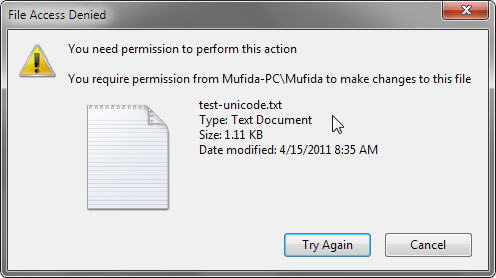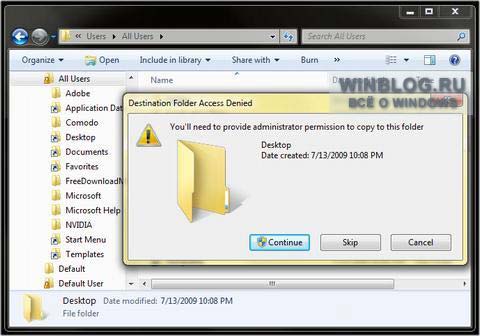-
Windows Vista Access Denied To Folders
Folder Guard for Windows 10, 8, 7, XP. Buy Folder Guard: Personal license $49.95 $39.95 Business license $99.95 $79.95 Try Folder Guard free: Download free trial. Ever try to delete a file and get an Access is Denied error? Or maybe you’re trying to copy or move a file or folder and you get a message stating the source file.
Folder Guard for Windows 10, 8, 7, XP. Buy Folder Guard: Personal license $49.95 $39.95 Business license $99.95 $79.95 Try Folder Guard free: Download free trial. Ever try to delete a file and get an Access is Denied error? Or maybe you’re trying to copy or move a file or folder and you get a message stating the source file.
How do I copy shortcuts to the All Users folders in Vista or Windows 7? If you are used to copying shortcuts to the Documents and Settings\All Users\Desktop or the Documents and Settings\All Users\Start Menu folders in Windows XP, you might be wondering how to do this in Windows Vista or Windows 7. You may have run across the.

Users\All Users\Desktop folder and thought that this is where the shortcut should go. But Figure A shows what you will see when you try to open it to view its contents. This signifies a shortcut to a folder. Actually, it is what Microsoft calls a Junction Point. A Junction Point is a way to automatically redirect access requests and provide backward compatibility. Since the Desktop and Start Menu folders are not actual folders, you get an Access Is Denied error when you try to open them in Windows Explorer. Note: Junction Points are visible in Windows Explorer only when Show Hidden Files, Folders, and Drives is selected and Hide Protected Operating System Files is deselected.
To change these options, open Windows Explorer and select Organize then Folder and Search Options. Alternatively, press the . In the Folder Options window, select the View tab.
Click to select the Show Hidden Files, Folders, and Drives radio button under Hidden Files and Folders. Click the Hide Protected Operating System Files check box to deselect it. This blog post is also available in PDF format in a free Tech. Republic download. There are two ways you can copy a shortcut to the Desktop or Start Menu folders.
Method One - Copy and paste shortcut to Junction Point. While you cannot open a Junction Point in Explorer to view its contents, you can copy and paste files to it. To do this, copy a shortcut and paste it to the Junction Point in the tree structure in the left pane. You can also click All Users in the left pane to expand it and paste the shortcut to the Junction Point in the right pane, as shown in Figure B.
Figure BCopy and paste a shortcut to the Junction Point, Desktop in this example, in the left or right pane. You will be asked to provide administrator permission. If you are using Vista, you will also be prompted by the UAC. Figure CClick Continue to provide administrator permission. The shortcut will be redirected and saved in the appropriate Vista or Windows 7 destination folder. Note: You cannot move, delete, or view files from a Junction Point using Explorer. Use method two to perform these functions.
Method Two - Copy to new folder location. Use the table below to find the new folder location for the Desktop and Start Menu folders. Other new folder locations can be found at this Web page.

Table ATable BThese are the old and new locations for the Desktop and Start Menu folders and the Junction Point location that links them. Navigate to the new folder in Explorer and paste it, as shown in Figure D. If you are using Vista, you will also be prompted by the UAC. As you can see in Figure D, Users\Public\Public Desktop is where the actual desktop shortcut files now reside in Vista and Windows 7. Author's Note. Thanks to Tech. Republic member Charlie Spencer (Palmetto) for the How do I question.
Stay on top of the latest XP tips and tricks with Tech. Republic's Windows XP newsletter, delivered every Thursday. Automatically sign up today!
If you get access denied, that means the security is messed up on the files in the recycle bin. Go to the Recycle bin in explorer, right click choose properties. This article shows how to use Access-Based Enumeration to hide shared files and folders from network users who are not authorized to access them. This helps prevent. If you are getting Access Denied error in Windows 7 then you are not alone. This error is quite common and occurs due to permission issues. There are some. Sometimes, even Windows administrator accounts encounter "access denied" errors on certain resources. When you see them, here's the easy way to gain access to the folder. When trying to access or work with files and folders you may get "Access Denied" or other errors. Here's what you can try to address the issue. This was easily one of the most frustrating and ridiculous fun times I've had working with DFS. The issue: At several client locations we run file server redundancy. You will get an Access Is Denied error when you try to open the Users\All Users\Desktop folder in Windows 7 Explorer. If you look closer at the Desktop folder icon in.




-
Commentaires
